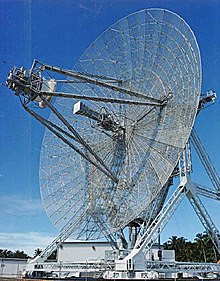Cassegrain telescope
The Cassegrain telescope [ kɑsˈɡʀɛ̃ ] is a reflecting telescope . In the literature it is sometimes referred to as the Jean or Giovanni telescope. It was introduced to the public in 1672 by the French scholar Laurent Cassegrain (approx. 1629–1693). Since the Newton telescope and the Gregory telescope were invented only a few years earlier , a Europe-wide discussion about the advantages and disadvantages of these systems took place.
Similar to the Newton telescope and the Gregory telescope, the beams bundled by the main mirror are directed to the receiver laterally via an auxiliary mirror (Newton) or through an opening in the main mirror.
The incident light falls on a concave - parabolic main mirror (the primary mirror ). This reflects the light to a convex - hyperbolic secondary mirror , the secondary mirror . It is arranged in such a way that its virtual focal point on its concave side corresponds to that of the large parabolic mirror. Its focal point, lying on its convex side, points in the direction of the main mirror. Either the receiver is in front of the main mirror (only with non-optical Cassegrain, see picture of the radar antenna), or the reflected rays reach it through an opening in the main mirror. Alternatively, the rays can also be thrown laterally out of the tube by means of a plane mirror before reaching the main mirror. This position of the focal plane is called the nasmyth focus .
Unlike the Newton telescope (auxiliary mirror is ground flat) and like the Gregory telescope (auxiliary mirror is a concave ellipsoid), the convex-hyperbolic auxiliary mirror extends the focal length and enables compact designs. In contrast to the Gregory telescope, the secondary mirror is closer to the main mirror than its focal point, which allows for a shorter design.
The image field is curved and other optical errors also occur. This is especially true when a spherical primary mirror is used for small telescopes . To a certain extent, these errors can be reduced by retouching the secondary mirror.
Other reflecting telescopes are based on the Cassegrain telescope and try to reduce image errors in different ways:
- Nasmyth telescope
- Schmidt-Cassegrain telescope
- Maksutov telescope
- Hypergraph telescope
- Ritchey-Chrétien-Cassegrain telescope (RC telescope)
The RC system has established itself in the construction of very large telescopes, see z. B. the Very Large Telescope .
literature
- Rolf Riekher: Telescopes and their masters . 2nd Edition. Technik GmbH, Berlin 1990, ISBN 3-341-00791-1 , p. 91-94 .

